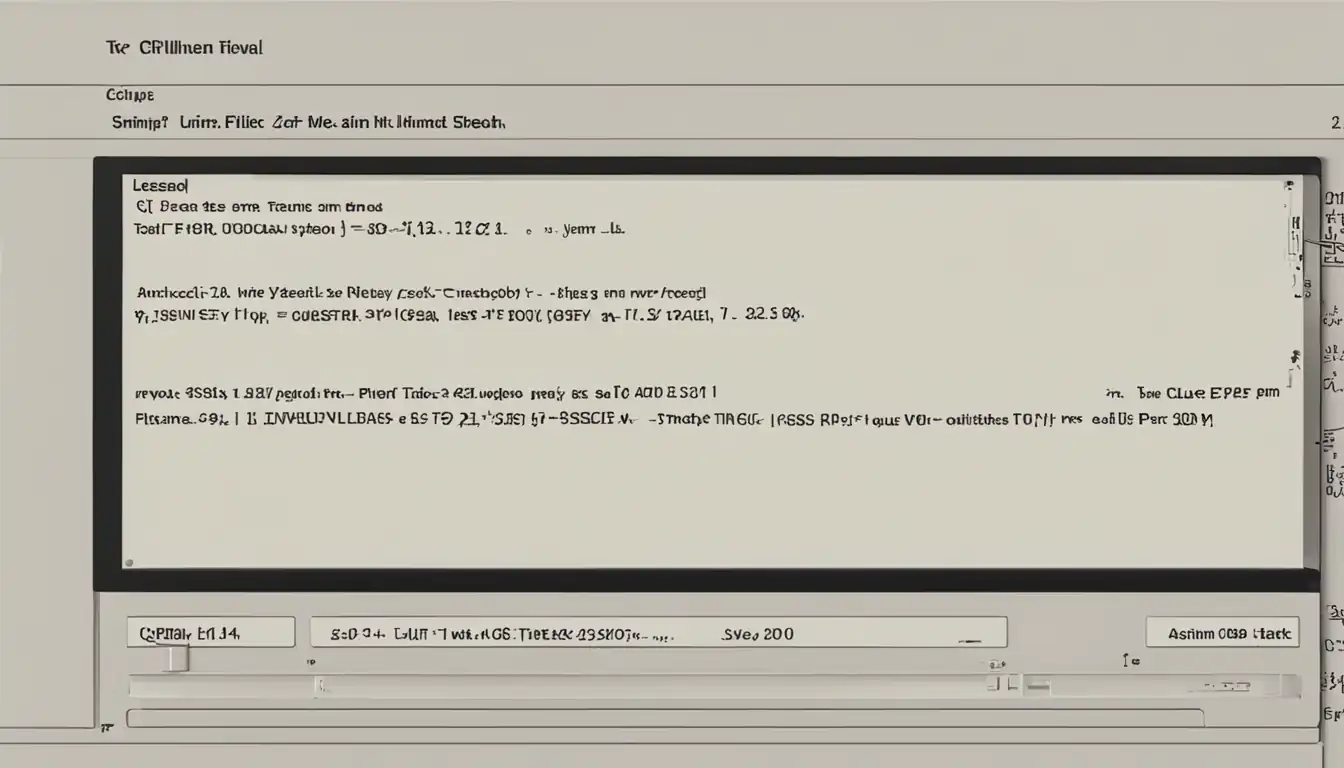Understanding Text File Types: A Comprehensive Guide

Introduction
In the world of computing, text files play a crucial role in storing and exchanging information. Understanding different text file types is essential for efficient data management and compatibility. This comprehensive guide will provide an overview of various text file formats, their characteristics, and how to choose the right file type for different use cases.
What Are Text Files?
 Text files are files that contain plain text data without any formatting or special characters. They are widely used for storing and exchanging information in a readable format. Unlike binary files, which store data in a format that is not easily readable by humans, text files can be opened and edited using simple text editors.
Text files are files that contain plain text data without any formatting or special characters. They are widely used for storing and exchanging information in a readable format. Unlike binary files, which store data in a format that is not easily readable by humans, text files can be opened and edited using simple text editors.
Importance of Text File Types in Computing
Text file types are essential in computing for several reasons. They allow for easy sharing of information across different platforms and applications. They are also lightweight and take up less storage space compared to other file formats. Additionally, text files are compatible with a wide range of software, making them versatile for various purposes.
Common Text File Formats
There are several common text file formats that are widely used in computing. Let's explore some of them:
Plain Text Files
Plain text files are the simplest form of text files. They contain unformatted text and have a file extension of .txt. Plain text files can be opened and edited using any text editor.
.TXT Files
.TXT files are the most basic and widely supported text file format. They are commonly used for storing and exchanging plain text data. .TXT files can be opened and edited using any text editor, making them highly versatile.
.CSV Files
.CSV (Comma-Separated Values) files are used for storing tabular data, such as spreadsheets or databases. Each value in a .CSV file is separated by a comma, allowing for easy organization and manipulation of data. .CSV files can be opened and edited using spreadsheet software or text editors.
Rich Text Files
Rich Text Files (RTF) are text files that allow for formatting and styling of text. They have a file extension of .rtf and can be opened and edited using word processing software.
.RTF Files
.RTF files are commonly used for creating documents with formatting, such as bold, italics, and different font styles. They can be opened and edited using word processing software like Microsoft Word or Google Docs.
.DOC and .DOCX Files
.DOC and .DOCX files are file formats used by Microsoft Word for creating and editing documents. These files can contain rich text formatting, images, tables, and other elements. .DOC files are the older format used by older versions of Microsoft Word, while .DOCX files are the newer XML-based format.
Source Code Files
Source code files are text files that contain instructions written in a programming language. They are used to create software applications and websites.
.HTML and .CSS Files
.HTML files are used for creating web pages and defining their structure. .CSS files, on the other hand, are used for styling the appearance of web pages. Both .HTML and .CSS files can be opened and edited using any text editor.
.JS Files
.JS files are used for adding interactivity and functionality to web pages. They contain JavaScript code that is executed by web browsers. .JS files can be opened and edited using any text editor.
.PY Files
.PY files are used for writing Python scripts. Python is a popular programming language used for various purposes, including web development, data analysis, and automation. .PY files can be opened and edited using any text editor or specialized Python IDEs.
Configuration Files
Configuration files are text files that contain settings and parameters for software applications or operating systems.
.INI Files
.INI files are used for storing configuration settings in a simple and readable format. They consist of sections, keys, and values. .INI files can be opened and edited using any text editor.
.CONF Files
.CONF files are commonly used in Unix-like operating systems for configuring system settings and applications. They are often written in a specific syntax and can be opened and edited using any text editor.
Markdown Files
Markdown files are text files that use a lightweight markup language for formatting. They have a file extension of .md and are commonly used for creating documentation or writing articles.
.MD Files
.MD files are written in Markdown syntax, which allows for easy formatting of text, including headings, lists, tables, and links. .MD files can be opened and edited using any text editor or specialized Markdown editors.
Characteristics of Text File Types
 Text file types have certain characteristics that differentiate them from one another. Let's explore some of these characteristics:
Text file types have certain characteristics that differentiate them from one another. Let's explore some of these characteristics:
Encoding Formats
Encoding formats determine how characters are represented in a text file. Two common encoding formats are ASCII and Unicode.
ASCII vs. Unicode
ASCII (American Standard Code for Information Interchange) is a character encoding standard that uses 7 bits to represent characters. It supports a limited set of characters and is primarily used for English text.
Unicode, on the other hand, is a character encoding standard that supports a much larger set of characters from various languages and scripts. It uses variable-length encoding and can represent characters from almost all writing systems in the world.
MIME Types and Their Role
MIME (Multipurpose Internet Mail Extensions) types are used to identify the type of content in a text file. They play a crucial role in web development and email communication, as they allow software to interpret and handle different file types correctly.
How to Choose the Right Text File Type
Choosing the right text file type depends on several factors. Here are some considerations to keep in mind:
Considerations for Compatibility
When choosing a text file type, consider the compatibility with the software or systems you intend to use. Ensure that the file type is supported by the applications or platforms you plan to work with.
Security Aspects of Text Files
Consider the security implications of the file type you choose. Some file types may have vulnerabilities that can be exploited by malicious actors. Ensure that you choose a file type that is secure and does not pose any risks to your data or systems.
Use Cases for Different File Types
Different file types are suitable for different use cases. Consider the purpose of your text file and choose a file type that best suits your needs. For example, if you need to create a document with rich formatting, a .DOCX or .RTF file would be more appropriate. If you need to store tabular data, a .CSV file would be a better choice.
Working with Text Files
Working with text files involves opening, editing, and converting them. Here are some common methods:
Opening and Editing Text Files
Text files can be opened and edited using various software tools. Some popular options include:
Notepad and TextEdit
Notepad (for Windows) and TextEdit (for macOS) are basic text editors that come pre-installed on most operating systems. They allow for simple editing of text files and are suitable for basic tasks.
Code Editors and IDEs
Code editors and Integrated Development Environments (IDEs) are more advanced tools that offer features specifically designed for programming and web development. Examples include Visual Studio Code, Sublime Text, and PyCharm.
Converting Between Text File Types
Sometimes, it may be necessary to convert text files from one format to another. Here are two common methods:
Online Tools
Several online tools allow for easy conversion between different text file formats. These tools typically support a wide range of file types and provide a user-friendly interface for converting files.
Software Solutions
Specialized software applications can also be used to convert text files. These applications often offer advanced features and batch processing capabilities, making them suitable for large-scale conversions.
Best Practices for Managing Text Files
To ensure efficient management of text files, consider the following best practices:
Version Control for Text Files
Implementing version control systems, such as Git, can help track changes and collaborate on text files effectively. Version control allows for easy rollback to previous versions and helps maintain a history of file modifications.
Backup and Recovery Strategies
Regularly backing up text files is essential to prevent data loss. Implement a backup strategy that suits your needs, whether it's using cloud storage, external hard drives, or network-attached storage (NAS). Additionally, consider implementing recovery strategies to restore files in case of accidental deletion or system failures.
Conclusion
Text file types are a fundamental aspect of computing, allowing for the storage and exchange of information in a readable format. Understanding different text file formats, their characteristics, and how to choose the right file type is crucial for efficient data management and compatibility. By following best practices and considering the specific requirements of your use case, you can effectively work with text files and ensure the security and integrity of your data.
The Future of Text File Formats
As technology continues to evolve, text file formats are likely to adapt and improve. New formats may emerge, offering enhanced features and compatibility. It's important to stay updated with the latest developments in text file formats to make informed decisions and leverage new capabilities.
Summary of Key Takeaways
- Text files are plain text files without any formatting or special characters.
- Common text file formats include .TXT, .CSV, .RTF, .DOCX, .HTML, .CSS, .JS, .PY, .INI, .CONF, and .MD.
- Text file types have different characteristics, such as encoding formats and MIME types.
- When choosing a text file type, consider compatibility, security aspects, and use cases.
- Text files can be opened and edited using various software tools, including basic text editors and specialized code editors/IDEs.
- Conversion between text file types can be done using online tools or specialized software applications.
- Best practices for managing text files include implementing version control and backup/recovery strategies.
FAQs About Text File Types
Q: Can I open a .TXT file with Microsoft Word? A: Yes, .TXT files can be opened and edited using Microsoft Word. However, keep in mind that .TXT files do not support formatting, so any formatting in the file will be lost when opened in Word.
Q: What is the difference between .DOC and .DOCX files? A: .DOC files are the older file format used by older versions of Microsoft Word, while .DOCX files are the newer XML-based format. .DOCX files offer improved compatibility, smaller file sizes, and enhanced features compared to .DOC files.
Q: Can I convert a .CSV file to an Excel spreadsheet? A: Yes, .CSV files can be easily imported into spreadsheet software like Microsoft Excel. Most spreadsheet software provide options to import .CSV files and convert them into a tabular format.
Q: Are .MD files suitable for creating web pages? A: .MD files are commonly used for creating documentation or writing articles. While they can be converted into HTML for web publishing, they are not typically used as the primary format for creating web pages. HTML files are more suitable for that purpose.
Q: How can I ensure the security of my text files? A: To ensure the security of your text files, follow best practices such as using strong passwords, encrypting sensitive data, regularly updating software, and implementing access controls. Additionally, be cautious when opening text files from unknown or untrusted sources.